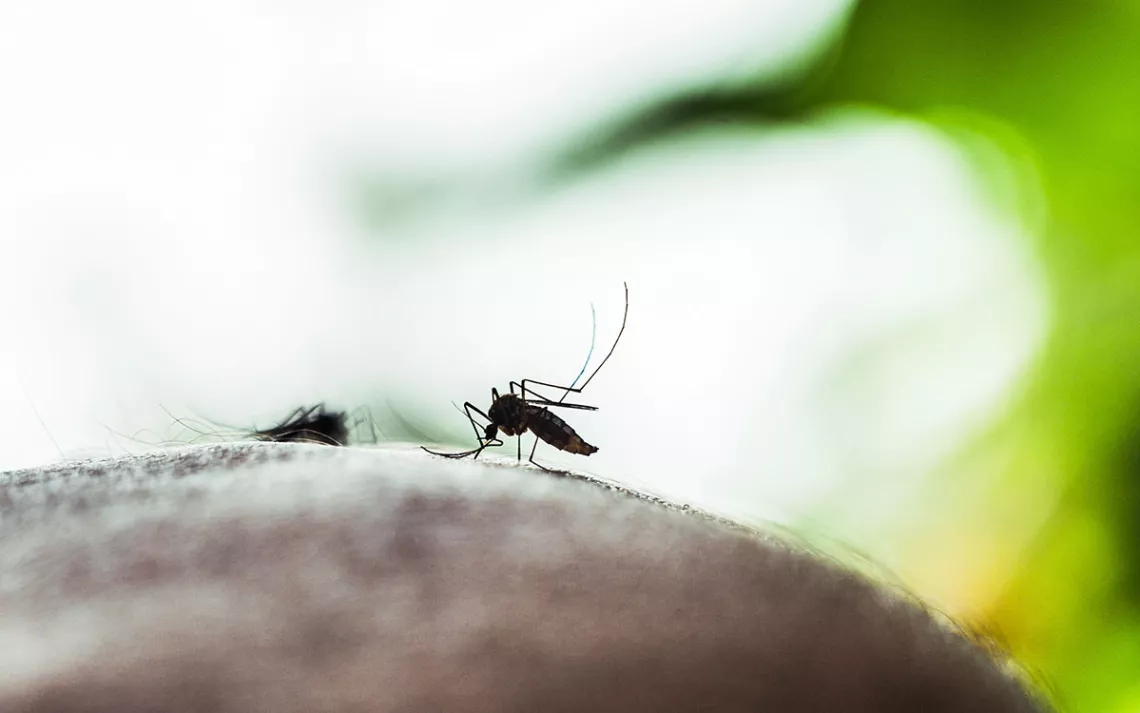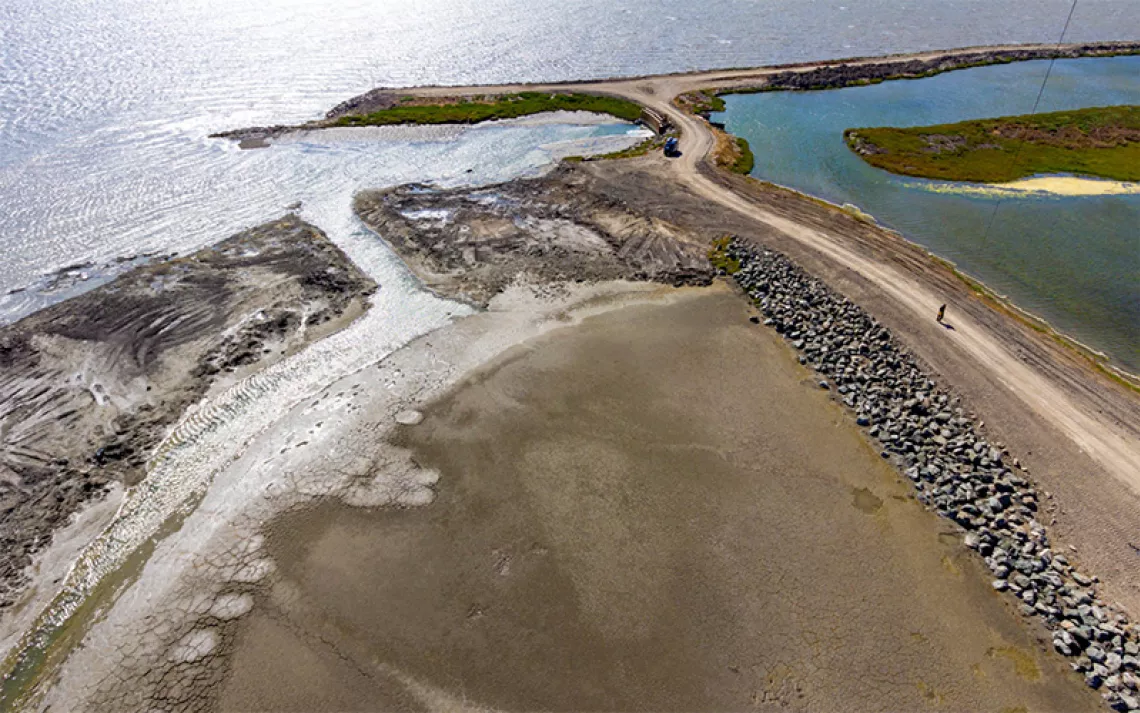Dengue Fever Is Spreading With Climate Change and Urbanization
The mosquito-borne disease is on the rise even in countries with no history of dengue epidemics

The Aedes mosquito is a known vector of several viruses including yellow fever, dengue, chikungunya, and Zika. | Photo by Soumyabrata Roy/NurPhoto via AP
Editor's Note: Just a few weeks after Sierra first published this story, Puerto Rico declared a public health emergency on March 25, 2024, in response to a historic rise in reported dengue cases. At the time of the declaration, just about three months into the year, 549 cases had already been reported, compared with the 1,293 total cases reported in 2023. Puerto Rico is one of many places around the world that is feeling a marked increase in the presence of the virus each year, following shifting patterns in climate and urbanization.
In the photo, a woman has passed out. Her eyes are closed and her body limp as a man and a woman hold her upright, trying to drag her across a brick pathway to get help.
Behind the trio is a large army-green tent, rounded at the top with its door and windows zipped shut. It’s one of many that have been set up by the Brazilian Air Force in Ceilândia, a suburb of capital city Brasília, to provide medical care for as many as 600 residents who suspect they have the mosquito-borne viral disease dengue fever.
The photo, published in the national newspaper Folha de S.Paulo last month, has made the rounds online, a shocking visual representation of how dire the situation has become in Brazil both this year and last, as record-high numbers of dengue fever cases and deaths ravage the country.
And it’s not alone.
Now, places that have never had a problem with the disease, including hot and humid regions of the US, Europe, and Sudan, are registering uncharacteristically high numbers too. Other tropical countries used to dealing with dengue, such as Peru, Bangladesh, Vietnam, and Sri Lanka, are seeing severe epidemics devastate their populations similarly to Brazil.
Experts pinpoint climate change as one of the main factors for this increased spread. Higher temperatures, heavier rains, and more expansive flooding have created ideal breeding grounds for the Aedes aegypti mosquito, responsible for carrying and spreading the dengue virus. As the urban-dwelling insects become more common, those who study the disease and its transmission warn that it’s time for authorities to be vigilant in using disease monitoring. It’s a prevention effort that can help health-care systems prepare to bear the weight of dengue fever becoming more globally present and more severe.
Before 1970, severe epidemics of the mosquito-borne disease had only occurred in seven countries. But according to the World Health Organization, there has been an eightfold increase in yearly reported dengue fever cases over the last two decades, with about half the world’s population at risk of infection and 100 to 400 million cases registered worldwide each year.
Since 2010, scientists in Brazil have identified all four distinct variations of the dengue virus, or serotypes, causing even more concern. With one serotype present, people only contract dengue fever once and generally with mild symptoms—fever, rash, muscle and joint pain. But having other serotypes circulating means a second infection is possible, which often leads to hemorrhagic dengue and more dangerous symptoms, such as persistent vomiting, bleeding from the gums and nose, difficulty breathing, and death.
Dengue fever is a viral disease found in tropical and subtropical climates. Infected female Aedes aegypti mosquitoes transmit the virus to humans when they bite us in search of the protein-rich blood necessary to feed their eggs. (Since dengue isn’t contagious human-to-human, the virus can only spread to new regions with mosquito migration, not when humans travel while infected, as with Covid.) These same mosquitoes can also carry yellow fever, West Nile, chikungunya, and Zika viruses.
Mosquitoes lay eggs on the surface of stagnant water, where larvae develop and pupate before becoming mature adult mosquitoes. Aedes aegypti evolved to prefer human blood because where we live in dense urban and semi-urban areas provides many such breeding areas—in construction sites, tire shops, cemeteries, abandoned swimming pools, and flower pots. Anywhere we have forgotten water.
Changes in our behaviors, such as migration and increased urbanization, therefore impact where this particular mosquito makes its home. Ultimately, however, climatic shifts in global temperatures and weather are the most important drivers behind these mosquitoes' ever-expanding range, as well as how easily they can transmit the virus they carry.
“Because of the increasing rains, there are more breeding sites,” says Neelika Malavige, head of Dengue Global Programme and Scientific Affairs at the Drugs for Neglected Diseases initiative (DNDi). “And at higher temperatures, the biting rate of mosquitoes increases, which, of course, leads to more dengue infections.” Malavige also notes that high temperatures speed up the mosquito’s developmental cycle, increasing the incidence of adult females out for blood. But without increased water, higher temperatures alone don’t mean “that suddenly Montana and the UK are going to have problems with dengue,” says Janey Messina, an expert in spatial epidemiology at the University of Oxford who studies the distribution of dengue and its risk to the population.
In Pakistan, a surge in dengue cases in 2022 came after the country saw catastrophic flooding caused by rising sea temperatures and an unprecedented monsoon season. Peru saw its worst-ever outbreak in 2023 following torrential rains. In Nepal, dengue has been reported more frequently at higher altitudes now that temperatures are high enough for mosquitoes to survive there. Dengue transmissions used to be linked to seasonal monsoon patterns in Sri Lanka but are now year-round due to intensifying rainfall. Even some previously unaffected subtropical countries, such as Niger, have reported their first dengue cases.
Across the US, some 1,000 mosquito control units, mostly run by municipal and state governments, work to control mosquito-borne diseases through research and surveillance of mosquito populations. They track which mosquito species are in their region, where they are, and their abundance as well as attending to resident complaints and responding to disease cases. In the last year, Texas, Florida, and California have all seen a sprinkling of unexpected dengue cases.
At the Miami-Dade County Mosquito Control Division, experts also monitor for insecticide resistance and mosquito activity patterns to more effectively target what it sprays and when. Last year, the county registered 161 locally transmitted dengue infections, and so far this year at least one case is under investigation to determine where it was acquired.
According to John-Paul Mutebi, director of the Miami-Dade County Mosquito Control Division and formerly a research entomologist at the Centers for Disease Control and Prevention’s Division of Vector-Borne Diseases, the situation in the county is under control. But that doesn’t mean he and his team of 50 aren’t remaining vigilant and looking to do everything they can to prevent further spread of the virus.
“We’re interested in the proportion of mosquitoes that are infected with a pathogen, because that is how we estimate risk,” he says. “There’s an infection-rate index that tells you when people are going to start getting sick.”
In France and other countries like it, these tips could be useful. Considered neither tropical nor subtropical, the European nation had no locally transmitted cases prior to 2010. But by mid-October of 2022, 65 such cases had been reported that year.
“Health systems need to be given proper preparation to deal with this,” says André Siqueira, an infectious-disease expert at Brazil’s Oswaldo Cruz Foundation. “Health-care professionals need to be trained to identify the warning signs of dengue and the signs that it’s getting worse.”
The signs, he reiterates, are not always easy to spot because of their similarities to symptoms of other diseases mosquitoes spread, such as chikungunya and Zika. Treatment needs to start quickly, especially to stave off dehydration, which can cause shock, but there are no antiviral medications available that specifically target dengue, leaving health-care professionals to treat patients’ symptoms rather than the viral disease.
Fighting dengue ultimately requires multiple strategies, both post-infection care and outright prevention. Brazil started vaccinating against dengue through its public health-care system for the first time in February, offering Qdenga, a vaccine developed in Japan. It’s also available through private plans in several countries across Europe, the UK, Indonesia, and Thailand and in private and public health-care systems in Argentina. The two-dose vaccine has shown 80 percent efficacy a year after patients received the second dose. Biological research center Butantan Institute, located in São Paulo, is expected to have its own single-dose vaccine ready for use next year. In its most recent clinical trials, the vaccine showed 79.6 percent efficacy over a period of two years.
Like many other countries, Brazil also carries out regular mosquito foggings, spraying fine droplets of low-concentration insecticides mixed with water to kill the insects. Educational campaigns are also a crucial part of its dengue-prevention program. Such talks in schools, community centers, and other public spaces focus on how dengue is transmitted, the importance of removing any possibility of stagnant water from your home, and what to do if you have symptoms.
“You’re not going to find [Aedes aegypti] in the forest or the woods; they’re going to be close to humans,” says Mutebi. “They’ve been following us all over the world, and they’re very good at what they do, so we take this very seriously.”
Correction made March 18, 2024: An earlier version of this article misstated the number of annual dengue fever cases registered in Miami-Dade County in 2023. It is 161, not 14 (the latter is a monthly tally from 2023).
 The Magazine of The Sierra Club
The Magazine of The Sierra Club







